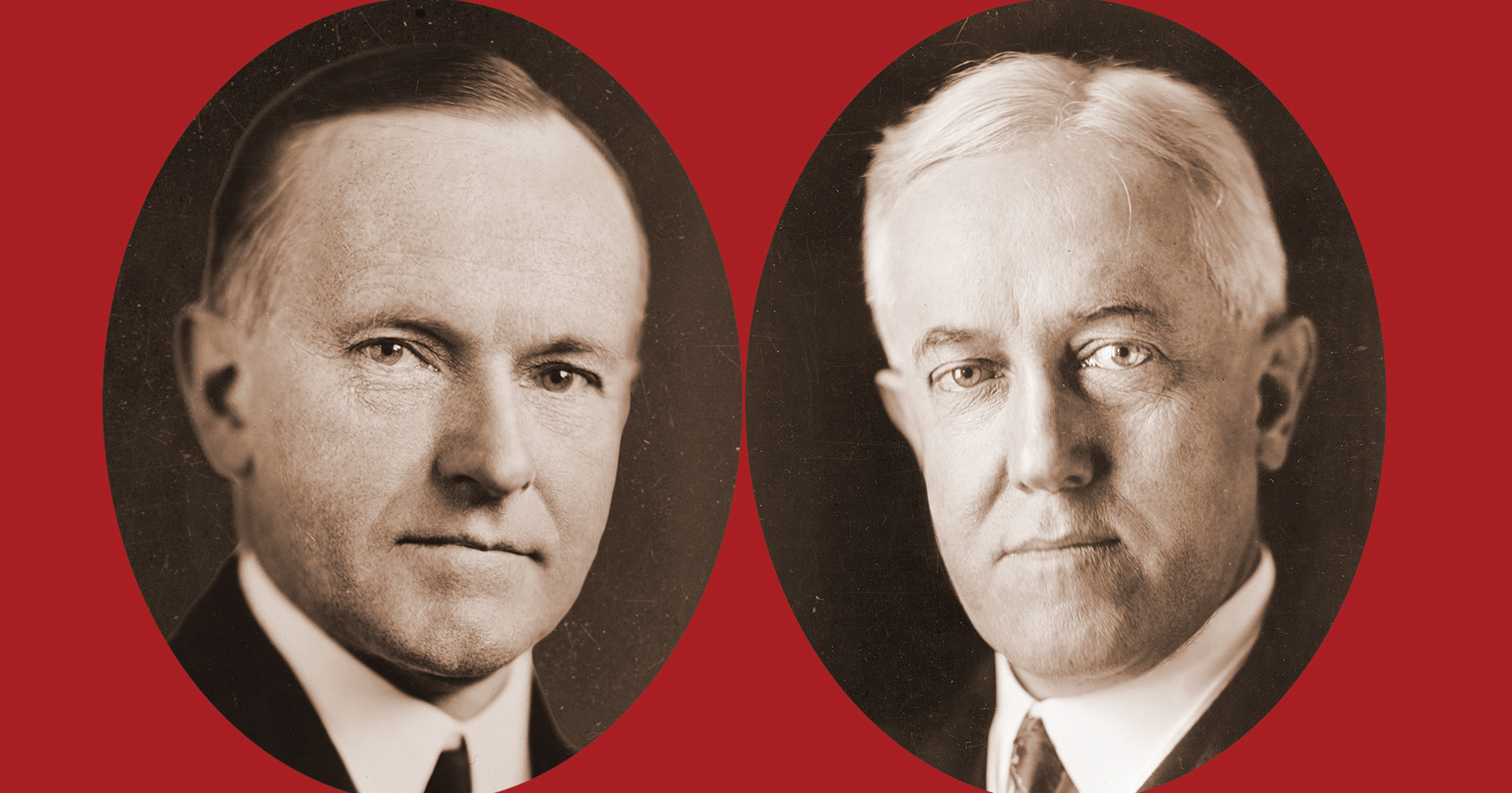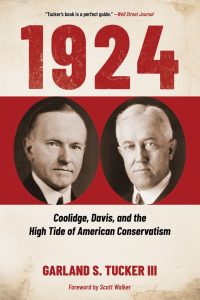By Garland S. Tucker III

The following is adapted from Garland S. Tucker III’s new book, 1924: Coolidge, Davis, and the High Tide of American Conservatism (Coolidge Press).
The 1924 presidential election is first and foremost the story of two remarkable men, John W. Davis and Calvin Coolidge. Modern historians have consistently, and regrettably, ignored or belittled them. While Coolidge has been dismissed as an accidental president who did nothing and thought nothing, Davis has faded into obscurity.
Calvin Coolidge was, in historian Paul Johnson’s words, “the most internally consistent and single-minded of American presidents.” He was a successful and able politician who, despite the sobriquet “Silent Cal,” has left an articulate record of his conservative creed. He was repeatedly elected to office by the people of Massachusetts, finally serving as governor. In 1920, he was elected vice president under President Warren Harding and stepped into the presidency upon Harding’s death in 1923. With the gradual revelation of Harding administration scandals, it was a tribute to Coolidge’s integrity that no scandal touched him.
Not only did he articulate a coherent, thoughtful strand of conservatism, but he also came to be seen—accurately—as an icon of the solid American values of honesty, hard work, self-reliance, and thrift. In an age of sound bites, spin, image handlers, and the like, it is refreshing to discover a president who was in every sense himself. Calvin Coolidge was the real thing—like him or not, you knew what he was.
The Democratic nominee in 1924, John W. Davis, was a man of unimpeachable integrity, immense personal charm, and extraordinary legal ability. He emerged from the House of Representatives to serve under President Woodrow Wilson, with widely recognized distinction, as solicitor general and as ambassador to Great Britain. He headed a major Wall Street firm, serving as counsel to J. P. Morgan & Co. and many other major corporations, and was president of the American Bar Association.
By the end of his career, he had argued more cases before the Supreme Court, 140 in all, than anyone since Daniel Webster and was hailed among his profession as truly a lawyer’s lawyer.
Davis was an articulate champion of conservatism as a candidate in 1924, as a major opponent of the New Deal, and as a brilliant advocate before the Supreme Court. Although it is difficult for the modern reader to imagine, there appears never to have been even a trace of self-promotion in Davis’s long career; he was always put forward for office by friends who knew him well. As the renowned journalist Walter Lippmann observed of Davis, “I have seen a good many men under the awful temptation of the presidency. I have never seen another who had such absolute respect.”
Two Conservatives
 Although Coolidge and Davis had very different personalities, there were interesting similarities in their political lives. Both were successful politicians, both emerged politically in the early Progressive era, both became increasingly conservative, both exemplified great integrity and personal ethics, and both reflected the best qualities of their respective regions.
Although Coolidge and Davis had very different personalities, there were interesting similarities in their political lives. Both were successful politicians, both emerged politically in the early Progressive era, both became increasingly conservative, both exemplified great integrity and personal ethics, and both reflected the best qualities of their respective regions.
Davis was a Democrat dedicated to small government, states’ rights, individual freedom, and free trade in the tradition of Jefferson, Madison, and Cleveland. Coolidge was a conservative Republican in the tradition of Lincoln, McKinley, and Harding.
Both revered Jefferson’s philosophy of limited government and individual freedom; coincidentally, Davis was born on Jefferson’s birthday, and Coolidge was born on the Fourth of July.
The old progressive warhorse William Jennings Bryan observed at the Democratic convention in July 1924 that Davis was a man of fine character. But he added with disgust, “So is Mr. Coolidge. There is no difference between them.”
A Forgotten Campaign
The 1920s—the setting for this story—is a decade long dismissed as a time of ephemeral prosperity, overshadowed and discredited by the events of the Great Depression and the ensuing New Deal progressivism. The majority of American historians have viewed this decade as a temporary interruption in the rise of progressivism, sandwiched between Woodrow Wilson and Franklin D. Roosevelt.
As Coolidge biographer Robert Sobel noted: “Few presidents in all American history had as many acolytes among intellectuals as did Woodrow Wilson. Arthur M. Schlesinger Jr. was an ardent admirer of Wilson, whom he saw as the president who played John the Baptist for Franklin D. Roosevelt. Schlesinger was one of those who helped fashion this legend. In The Age of Roosevelt, in which Schlesinger presented this thesis, he discussed the coming of the Republicans as though they were barbarians sacking Rome.”
Schlesinger was not alone in his partisan depiction of the Republican-dominated 1920s. In the widely acclaimed A Pocket History of the United States, Allan Nevins and Henry Steele Commager claimed, “The idealism of the Wilson era was in the past, the Rooseveltian passion for humanitarianism was in the future. The decade of the twenties was dull, bourgeois, and ruthless.”
Two generations of American historians have now viewed the 1920s through the Schlesinger/Nevins/Commager prism. No wonder the prevalent popular view of this era is in need of some historical balance. As economist Paul Rubin has written, “We now know that FDR’s policies likely prolonged the Great Depression because the economy never fully recovered in the 1930s, and actually got worse in the latter half of the decade.”
With hindsight, the twentieth century can be viewed in the context of a long-term national struggle between conservatism and liberalism. As Paul Johnson concluded, “Coolidge Prosperity was huge, real, widespread,” and it “showed that the concept of a property-owning democracy could be realized.” When viewed through this prism, the 1920s can be recognized as a period of remarkable economic growth, affirmation of basic conservative values, and emphasis on individual freedom and responsibility.
Buried within this decade of the 1920s, the 1924 presidential campaign lies largely forgotten. Much as the far more heralded election of 1912 represented the high tide of Progressivism, the election of 1924 can convincingly be viewed as the high tide of American conservatism. Of the twentieth-century presidents, Calvin Coolidge was the most Jeffersonian in philosophy and practice. And John W. Davis was the last nominee from the conservative, Jeffersonian wing of the Democratic Party.
It is remarkable that both political parties nominated a bona fide conservative. This election stands as a defining moment in the history of American presidential elections.
The Onset of Polarization
One other notable aspect of the 1924 campaign: Senator Robert La Follette, a progressive Republican, ran as a third-party candidate, briefly resurrecting the Progressive Party. In the end, La Follette and his progressive ideals won less than 17 percent of the vote, with the conservative candidates taking the rest.
More important, the polarization so familiar to Americans today began after this election. La Follette died only months after the 1924 vote. But his progressive heirs would find a home among Democrats rather than with the GOP. The term “progressive Republican” might sound like an oxymoron to modern ears, but it was common for years leading up to the 1924 election.
Nor can Republicans alone be blamed for the onset of polarization. After 1924, the Democratic Party moved leftward. Indeed, shortly after Election Day, Franklin Roosevelt commented that it was useless for the Democrats to “wear the livery of the conservative.”
It’s a lesson the Democrats have not yet forgotten.
Take a Fresh Look
As the country continues to debate the proper role of government in a free society, Americans should reconsider the significance of the twenties, the 1924 election, and, most important, these conservative titans—John W. Davis and Calvin Coolidge.
Garland S. Tucker III is the author of Conservative Heroes and has written for National Review, the Washington Times, and other leading publications. He is a trustee of the Coolidge Foundation. This essay is adapted from his new book, 1924: Coolidge, Davis, and the High Tide of American Conservatism.